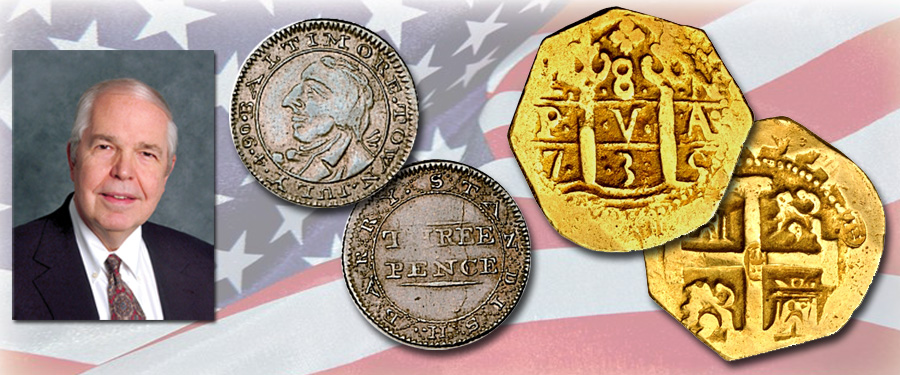
Nearly all coins in the American series have year dates, but not month or day dates. Among the exceptions are the Bechtler $5 gold coins minted in Rutherfordton, North Carolina, letterd “August 1. 1834.”
As to why this date appears is not a mystery. The federal Coinage Act of June 28, 1834, changed the weight and fineness of American gold coins, effective on August first. Christopher Bechtler labeled his coins with that date, advising that such coins conformed to federal standards.
There is another coin with a day and month date, but why July 4 was specifically chosen is not known.
This is the Standish Barry silver threepence issued in Baltimore.
In 2008 as part of the Whitman Encyclopedia of Colonial and Early American Coins I wrote the following. By reading it you will know as much as I do.
By the way, this is a great book that merits inclusion in your library. It will furnish a week of interesting and informative reading. This award-winning volume has been a best seller for Whitman. Alternatively, you can borrow a copy free of charge (but paying postage) from the ANA Library in Colorado Springs.
Here goes:
Standish Barry Coinage
1790
History
Standish Barry, a Baltimore silversmith, struck a distinctive silver threepence token in 1790. Barry, 27 years old at the time, may have intended the piece to commemorate the anniversary of American independence, or perhaps some special celebration was held in Baltimore that occasioned its issue. The piece bears a male portrait on the obverse, perhaps Barry himself. The specific day July 4 in addition to the year (expressed as 90) is a distinctive feature. The coinage production apparently was extremely limited for his threepence are exceedingly rare today.
About this time he is believed to have made imitation Spanish-American gold doubloons hallmarked SB, per the research of John Kraljevich in the description of a coin in the Eliasberg Collection sale, 2005, Lot 3012, a scenario similar to Ephraim Brasher’s imitation 1742 Lima gold doubloon.
Barry was born in Baltimore on November 4, 1763. By the age of 16 he had developed patriotic fervor and enlisted in the Revolutionary War. Afterward he set up business in the city of his birth, and engaged in a variety of activities, including silversmith, watchmaker, and jeweler. He first advertised as a watch and clock maker and engraver in the Maryland Journal on November 26, 1784, having completed his apprenticeship in the trade with David Evans. Not long afterward he became a partner with Joseph Rice, an arrangement that continued until June 1787. His memorable threepence pieces were issued several years later. In the meantime it seems that he was involved in the assaying of gold coins, and created his own versions imitating Spanish-American pieces. In New York City his contemporary, Ephraim Brasher, did the same thing. On October 10, 1788, he married Agnes Thompson. The couple had six children, one of whom, Standish Jr., served as an assistant treasurer of the United States.
Maintaining an interest in the military, by 1798 Barry was a lieutenant in the Baltimore Independent Blues, earlier called the Sans Culotte, organized to defend the city should a war with France develop. At that time the French were seizing American ships on the high seas, and tensions ran high. In the early 19th century he was listed in directories as a watchmaker and silversmith at 20 North Gay Street. In 1808 he was requested to quote for supplying 3,000 gross each of coat and vest buttons with insignia of the 1st and 2nd regiments.
During the War of 1812 he served in the battle with the British at Bladensburg, Maryland on August 24, 1814, and in the next month in Baltimore, when the British attempted to land after they had sacked Washington, but were repulsed by “the rockets’ red glare, the bombs bursting in air” fired by troops manning Fort McHenry in the harbor. Barry, or someone with a similar name, is found in later accounts in which he was a grocer and also held minor public offices.
In 1838 he moved to Newport, New York to live with his son, Standish Jr., where he died on November 6, 1844.
Nearly all examples of the silver threepence show significant wear, indicating that these must have circulated for a long time. The gold doubloon, a recent discovery, is unique.





